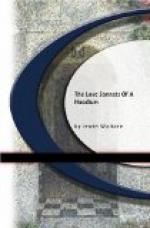In Mr. Irwin’s sonnet cycle, however, we have slang idealized, or as perhaps one might better say, sublimated. Evolution in the argot of the streets works by a process of substitution. A phrase of two terms goes through a system of permutation before it is discarded or adopted into authorized metaphor. “To take the cake,” for instance, a figure from the cake-walk of the negroes, becomes to “capture” or “corral” the “bun” or “biscuit.” Nor is this all, for in the higher forms of slang the idea is paraphrased in the most elaborate verbiage, an involution so intricate that, without a knowledge of the intervening steps, the meaning is often almost wholly lost. Specimens of this cryptology are found in many of Mr. Irwin’s sonnets, notably in No. V:
“My syncopated con-talk no avail.”
We trace these synonyms through “rag-time,” etc., to an almost subliminal thought — an adjective resembling “verisimilitudinarious,” perhaps, qualifying the “con” or confidential talk that proved useless to bring Mame back to his devotion.
In the masterly couplet closing the sestet of No. XVIII, Mr. Irwin’s verbal enthusiasm reaches its highest mark in an ultra-Meredithian rendition of “I am an easy mark,” an expression, by the way, which would itself have to be elaborately translated in any English edition.
Enough of the glamors of Mr. Irwin’s dulcet vagaries. He will stand, perhaps as the chief apostle of the hyperconcrete. With Mr. Ade as the head of the school, and insistent upon the didactic value of slang, Mr. Irwin presents in this cycle no mean claims to eminence in the truly lyric vein. Let us turn to a contemplation of his more modest hero.
I have attempted in vain to identify him, the “Willie” of these sonnets. The police court records of San Francisco abound in characters from which Mr. Irwin’s conception of this pyrotechnically garrulous Hoodlum might have been drawn, and even his death from cigarette-smoking, prognosticated in No. XXII, does not sufficiently identify him. Whoever he was, he was a type of the latter-day lover, instinct with that self-analysis and consciousness of the dramatic value of his emotion that has reached even the lower classes. The sequence of the sonnets clearly indicates the progress of his love affair with Mary, a heroine who has, in common with the heroines of previous sonnet cycles, Laura, Stella and Beatricia, only this, that she inspired her lover to an eloquence that might have been better spent orally upon the object of his affections. Even the author’s scorn does not prevent the reader from indulging in a surreptitious sympathy with the flamboyant coquetry of his “peacherino,” his “Paris Pansy.” For she, too, was of the caste of the articulate; did she not
“Cough up loops of kindergarten chin?”
and could we hear Mame’s side of the quarrel, no doubt our Hoodlum would be convicted by every reader. But Kid Murphy, the pusillanimous rival, was even less worthy of the superb Amazon who bore him to the altar. “See how that Murphy cake-walks in his pride!” is the cri-du-coeur the gentlest reader must inevitably render.




